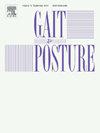通过双翼x线摄影显示步态中的脊柱骨盆参数
IF 2.2
3区 医学
Q3 NEUROSCIENCES
引用次数: 0
摘要
背景:在健康人群中,脊柱骨盆对髋关节力学和髋关节形态有影响。骨盆发生率(PI)和骶骨斜率(SS)是影响骨盆方向的脊柱骨盆参数,但它们对步态的影响尚不清楚。本研究的目的是探讨PI与步态中动态SS和髋关节运动学的关系,并确定PI和SS的性别差异。方法收集24名参与者在步行时的髋关节同步双翼x线片,并根据受试者的CT图像创建三维骨骼模型。在将骨骼模型与双翼x线片匹配后,使用经过验证的配准过程计算步态期间的三维髋关节运动学。CT图像测量PI, 3D骨模型测量SS。采用Pearson和Spearman相关分析PI、SS与归一化为站立的髋关节运动学之间的关系,采用非配对t检验和Wilcoxon秩和检验分析PI、SS的性别差异。结果PI与步态时最大SS (ρ=0.671, p = 0.002)和最小SS (ρ=0.639, p = 0.003)呈正相关。PI越大,步态时髋关节最大屈曲量越少(r = -0.365,p = 0.014),髋关节最大伸展量越大(r = -0.407,p = 0.006)。PI (p = 0.65)和SS (p = 0.53)无性别差异。结论pi和动态SS相互关联,并与步态中髋关节屈伸终点相关。这有助于深入了解CT显示的骨盆静态方向与步态过程中骨盆和髋关节动态运动学之间的关系。本文章由计算机程序翻译,如有差异,请以英文原文为准。
Spinopelvic parameters during gait revealed through biplane radiography
Background
Spinopelvic alignment impacts hip mechanics and influences hip morphologies in healthy populations. Pelvic incidence (PI) and sacral slope (SS) are spinopelvic parameters that influence pelvic orientation, but their impact on gait is less understood. The objectives of this study were to investigate the relationships of PI with dynamic SS and hip kinematics during gait, and to identify sex-based differences in PI and SS.
Methods
Synchronized biplane radiographs of the hip were collected from 24 participants during walking, and subject-specific 3D bone models were created from CT images. Three-dimensional hip kinematics during gait were calculated after matching the bone models to the biplane radiographs using a validated registration process. PI was measured in CT images and SS was measured from 3D bone models. Pearson and Spearman correlation was used to identify associations between PI and SS and hip kinematics normalized to standing, and unpaired t-test and Wilcoxon rank sum test was used to identify sex-based differences in PI and SS.
Results
There was a positive correlation between PI and maximum SS (ρ=0.671, p = 0.002) and minimum SS (ρ=0.639, p = 0.003) during gait. Greater PI was correlated with less maximum hip flexion (r = -0.365, p = 0.014) and more maximum hip extension (r = -0.407, p = 0.006) during gait. There were no sex-based differences in PI (p = 0.65) nor SS (p = 0.53).
Conclusion
PI and dynamic SS are associated with each other and with hip flexion and extension endpoints during gait. This provides insight into the relationship between static pelvis orientation from CT and dynamic pelvis and hip kinematics during gait.
求助全文
通过发布文献求助,成功后即可免费获取论文全文。
去求助
来源期刊

Gait & posture
医学-神经科学
CiteScore
4.70
自引率
12.50%
发文量
616
审稿时长
6 months
期刊介绍:
Gait & Posture is a vehicle for the publication of up-to-date basic and clinical research on all aspects of locomotion and balance.
The topics covered include: Techniques for the measurement of gait and posture, and the standardization of results presentation; Studies of normal and pathological gait; Treatment of gait and postural abnormalities; Biomechanical and theoretical approaches to gait and posture; Mathematical models of joint and muscle mechanics; Neurological and musculoskeletal function in gait and posture; The evolution of upright posture and bipedal locomotion; Adaptations of carrying loads, walking on uneven surfaces, climbing stairs etc; spinal biomechanics only if they are directly related to gait and/or posture and are of general interest to our readers; The effect of aging and development on gait and posture; Psychological and cultural aspects of gait; Patient education.
 求助内容:
求助内容: 应助结果提醒方式:
应助结果提醒方式:


